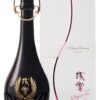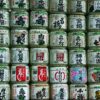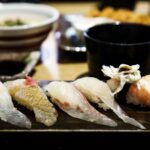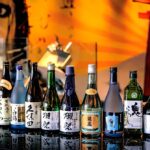How to drink sake. How to compare sake deliciously!
Custom way of drink sake!?? Sake professionals teach “How to compare sake deliciously”.
Have you ever been concerned about the “order of drinking sake"?
Sake has this kind of difference in taste, but there may be few people who care and know about the “order of drinking". If you eat something with a strong taste first, you may not feel it delicious even if you eat something lighter later, with this we think that many people became conscious of the “order of eating" when eating.
So, this time, We will talk about the “order of drinking sake" that we would like you to practice when comparing drinks.
* It is not always necessary to drink in this order. For reference only。
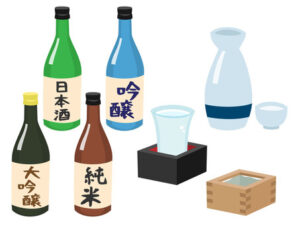
Contents
The basics of drinking in general order
Try drinking and comparing by specific name
Drink and compare by prefecture
Compare by taste
Summary
The basics of drinking in general order
For example, when eating sushi, there is a theory that you start with light-tasting eggs, then white meat, lean meat, and finally conger eel with a strong taste. This is because, as we mentioned earlier, if you eat something with a strong taste first, it will be difficult to feel the taste of something with a light taste that you ate later. Then, should sake be drunk according to such theory?
Sake is alcohol in which the more you get drunk in the second half, the more possible it is that you will not understand the taste or can drink more. So, if you already know your taste, or if you are proud of being “strong in alcohol!", Please try the following!
● Those who know their tastes
If you know what type of sake you like, we recommend drinking the first or second cup of sake. I also like to keep what I like until the end, but alcohol is not included!
Let’s drink what you like while you can drink it deliciously! Even if you like a strong liquor, you can drink a lot of water to refresh your mouth before going to the next liquor, so there is no problem!
● Those who have the pride of being “strong in alcohol"
Some people may say, “I can drink quite a bit, and I want to drink in order from light to strong," but it may be good to remember that “drink from expensive alcohol".
It is not always “high liquor = delicious liquor", but in general, the more time-consuming and expensive liquor such as Daiginjo and Junmai Daiginjo, the more delicate aroma and umami. Therefore, by drinking from the highest liquor, you can taste the delicate scented liquor to the rich liquor in order.
If you know the price, the price is high, and if you don’t know the price, the order is “DaiーGinjo or Junmai -Daiginjo → Ginjo or JunmaiーGinjo → TokubetsuーJunmai or TokubetsuーHonjou → Junmai or Honjou → Ordinary Sake". ..
Of course, there are exceptions, but I think it’s a good idea to keep it in the corner of your head when you drink from the sake with a strong name that comes with Ginjo.
● Those who do not apply to the above
Beginners of sake, those who like sake but can’t drink much! From here, we will teach you how to compare drinking sake!
Try drinking and comparing by specific name
Sake with a specific name refers to sake classified into eight types.
These are classified by the Liquor Tax Law due to differences in raw materials and manufacturing methods. I think it’s difficult to understand, so to give a concrete example, the categories such as “純米大吟醸JunmaiーDaiーGinjo" and “特別本醸造 TokubetsuーHonjozoshu" written on the label of sake are specific name sake. Here, We would like to recommend a method of drinking and comparing based on “specific name sake".
● When comparing two types
When drinking two types of sake, it is recommended to drink “from main brewing type to pure rice sake type" and “from ginjo sake type to pure rice sake type". What they have in common is that they bring “junmai sake" afterwards.
Junmaishu is a sake made only from “water" and “rice", so it has a strong umami and a rich taste. By drinking Junmaishu later, you can compare it only in the order of light to dark, and you can feel the taste of each.
● When comparing 3 or more types
When comparing three or more types of sake, try to drink from light taste to solid taste while referring to the classification of each specific name sake.
Specifically, “Daiginjo / Sparkling" → “Ginjo / Honjo" → “Junmai Ginjo" → “Junmai" → “Yamazukuri / Kimoto" → “Aged" The order of “Sake" is recommended! You may be wondering what to do with the three types compared to the two types, but if you look closely at the specific name sake, it’s not that difficult!
Drink and compare by prefecture
There is also a method of deciding the order by paying attention to the prefecture where the sake was made. It is said that many sakes have a refreshing taste as they are colder, and more and more sakes have a firmer taste as they go south.
In other words, if you think of a map of Japan and drink from north to south, you can compare the taste to something that is gradually stronger!
Specifically, “Tohoku liquor (cold region liquor)" → “Kanto Koshinetsu liquor" → “Kinki / Chubu region liquor" → “Kansai liquor" → “Kyushu liquor" It’s a feeling.
Of course, there are exceptions, but it will be helpful when deciding the order of drinking from light to dark. There is also a method of deciding the order by paying attention to the prefecture where the sake was made. It is said that many sakes have a refreshing taste as they are colder, and more and more sakes have a firmer taste as they go south.
In other words, if you think of a map of Japan and drink from north to south, you can compare the taste to something that is gradually stronger!
Specifically, it’s like “東北 Tohoku’s Sake" → “関東 甲信越 Kanto-Koushinetsu’s Sake" →"近畿 中部 Kinki & Chubu’s Sake" → “関西 Kansai’s Sake" →"四国 中国Shikoku & Chugoku’s Sake" → “九州Kyushu’s Sake".
Of course, there are exceptions, but it will be helpful when deciding the order of drinking from light to dark.
Compare by taste
There are also words that are useful in deciding the specific order of drinking and comparing in “expressions for taste and aroma" such as “端麗・淡麗 Tanrei(Light taste)" that you often see in shop menus.
● Simple scent → complex
One way is to start with the one with the simplest scent and then choose the one with the more complex scent.
You can enjoy the change in taste as well as the aroma by drinking and comparing from fruity to mellow.
● Light taste → Rich taste
There are times when the menus of shops have categories such as “Tanrei(light)" and “rich". The reference to this category is for you to try drinking from light to strong.
● Dry type → Strong umami type
The most useful way to drink sake at a store is to shift from “dry" to “strong umami taste sake".
If you don’t know which sake is dry and which one has a strong umami taste, take the plunge and ask the shop staff!
● Things with better acidity → Things with better sweetness
Like the expressions “dry" and “strong umami," the expressions “sour" and “sweet" of sake are often used. In fact, many sakes with high acidity have a relatively refreshing taste, and many sakes with superior sweetness have a rich and umami taste.
Therefore, it is recommended to taste “sake with sourness" first to “sake with sweetness".
● Things to taste cold → Things to taste at room temperature → Things to taste with hot sake
The “temperature" of sake is also a guide.
While the normal temperature, which is generally called “cold", is about 20 ° C, sake served at temperatures such as “snow cold" at about 5 ° C and “flower cold" at 10 ° C has a cold aroma. The taste is modest. It is easier to feel the difference in taste if you drink sake by shifting from well-chilled sake to normal temperature and hot sake.
● Fresh taste → ripe type
Fresh type sake is refreshing, and aged sake often has a complex taste, so you should be aware of it. It is also recommended to shift from a fresh and fresh type of sake to a more mature sake.
Summary
The taste of sake changes depending on the climate, storage conditions, and physical condition.
In addition, there are individual differences in the taste of people.
Depending on the sake, what is said to have a strong taste may feel light, and vice versa. I don’t think you can understand your tastes and indicators until you actually drink them, so we hope you will enjoy the comparison by referring to this article first.
In addition, please enjoy your sake life from various perspectives such as the order of drinking, the dishes to be combined, and the temperature of sake!
END.

